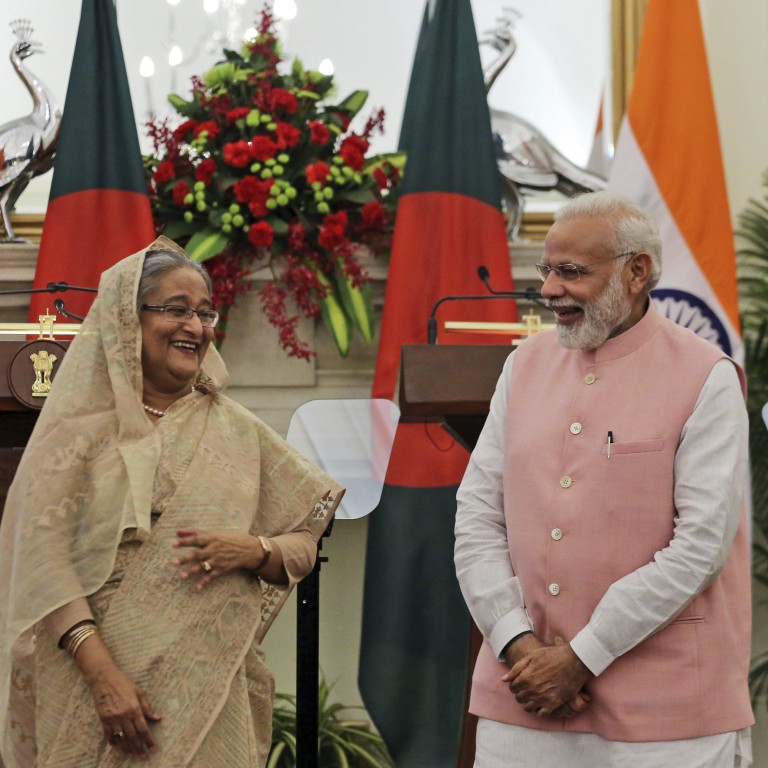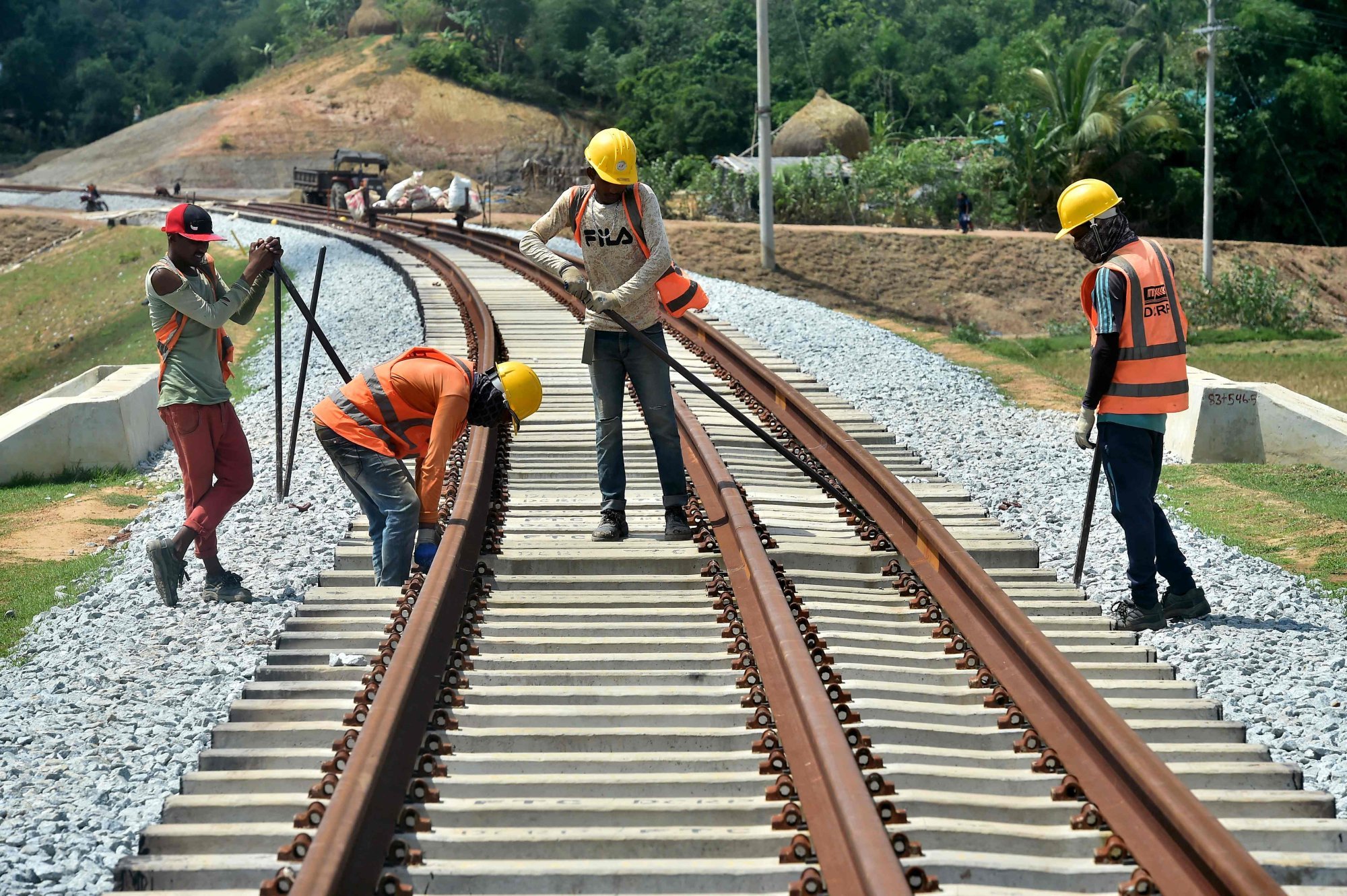
In South Asia, Bangladesh’s ‘deft’ balancing of US, China and India ties stands out
- Compared to some of its neighbours, Bangladesh is in good economic shape and the country is increasingly being viewed as an emerging middle power, observers say
- While its pursuit of ‘strategic ambiguity’ has given it good ties with China and India, it has also reached out to the US to reduce reliance on the Asian powers
While countries in South Asia are mired in economic crises or face a debt trap with China, Bangladesh has escaped such situations and is increasingly seen as an emerging middle power.
And despite being courted by the United States militarily, Dhaka has not been anxious to strengthen such ties as the government carries out a deft “three-way balancing” act between India, China and the US, analysts say.
In recent weeks, Sri Lanka has been going through its worst economic crisis since independence in 1948, and is on the verge of bankruptcy due to economic mismanagement and a massive shortage of foreign exchange reserves.
Without an IMF bailout, Sri Lanka faces ‘collapse beyond redemption’
In Nepal, depleting reserves, widening trade deficit and rising prices have prompted concerns that the Himalayan nation might be heading towards a full-blown economic crisis.
But not Bangladesh. At least, not yet.
While there are concerns about Dhaka’s foreign and domestic debt, Mustafizur Rahman, a distinguished fellow at the Centre for Policy Dialogue, told Dhaka Tribune last week that the country was still in a good position in two main indicators of debt management.
“One is the outstanding foreign debt-GDP ratio and the second is debt-servicing liability as a percentage of foreign exchange from export,” Rahman said.

Citing a study by the International Monetary Fund (IMF), economist Zahid Hussain said in the same report that the debt-to-GDP ratio was 90 per cent for developed countries, and 60 to 65 per cent for developing countries. In 2021, Bangladesh’s debt stood at US$131.14 billion, or 44.1 per cent of its GDP.
Lailufar Yasmin, international relations professor at the University of Dhaka, said the current state of South Asia had more to do with the poor internal management of the countries in question.
Yasmin said Bangladesh was cautiously observing the situation in its neighbourhood, learning from it, and had taken steps to ensure its foreign currency reserve was not affected. She added that Dhaka needed to actively pursue and attract foreign direct investments from different countries.
“The most FDI in the country comes from South Korea, contrary to popular perceptions,” Yasmin said, pointing out that Bangladesh was gradually becoming known as an emerging middle power in South Asia.
Why is Pakistan’s new PM so keen to accelerate the CPEC with Beijing?
Last week, the US Chamber of Commerce’s US-Bangladesh Business Council visited Dhaka and met Prime Minister Sheikh Hasina to discuss strengthening economic ties.
In April, Dhaka and Washington held a security dialogue at the US Department of State and discussed two defence agreements, the General Security of Military Information Agreement and Acquisition and Cross Servicing Agreement.
Keen to strengthen military ties with Bangladesh, the US has said that the agreements would help forge stronger defence ties and expand opportunities for defence trade, information sharing, and military-to-military cooperation.
However, Bangladesh foreign secretary Masud Bin Momen said last month that the country was in no hurry to sign the two agreements and would not purchase any arms from the US as it preferred to focus on economic development.

Yasmin said one of Bangladesh’s foreign policy goals was not to join any alliance or pacts tied to security, such as Washington’s Indo-Pacific Strategy (IPS) to bolster security and build resilience with its allies and partners amid China’s growing assertiveness.
“Bangladesh unhesitatingly stated that it shall only join the IPS when it shall have economic components,” Yasmin said, referring to the as-yet fully formulated Indo-Pacific Economic Framework that is US President Joe Biden’s new economic initiative for the Indo-Pacific region.
Ishrat Hossain, a doctoral candidate in international relations at the University of Oxford, said despite the recent high-level meetings between US and Bangladeshi officials, ties remained “prickly” due to Washington’s punishments of the Rapid Action Battalion (RAB) police force.
Last year, Washington imposed sanctions against RAB and seven of its current and former top officials for human rights abuses and abductions, in addition to extrajudicial killings. Dhaka has denounced the sanctions, while rights activists have described them as necessary, arguing that the force had acted with impunity during the government’s war on drugs.
“The punitive measures against RAB have worsened relations between Dhaka and Washington pushing Bangladesh further into China’s sphere of influence,” Hossain said.
How China-backed projects made Sri Lanka’s economic meltdown worse
Anu Anwar, a fellow at Harvard University’s Faculty of Arts and Sciences, said Bangladesh, located next to India, had maintained a “three-way balancing” between the US, India and China.
“Dhaka has pursued strategic ambiguity, maintaining good working relations with both China and India,” said Anwar who is also an associate in research at Harvard University’s John K. Fairbank Centre for Chinese Studies.
Anwar added that Dhaka had also reached out to the US in recent years aiming to use US-Bangladesh ties as “leverage” to set better terms with both China and India, defuse tension, and reduce reliance on both Asian powers.

Even though Washington had intensified its engagement with Dhaka, Anwar said these did not suggest that the US recognised “Bangladesh’s value in its own right”.
“The recent attention that Bangladesh is getting from Washington is under the assumption that Bangladesh is falling into China’s orbit,” Anwar said.
Last month, during a trip by India’s External Affairs Minister S Jaishankar to Bangladesh, Sheikh Hasina offered her country’s main seaport, Chittagong Port, to India to boost connectivity between the two countries.
India reciprocated by pledging to expand cross-border energy, hydropower and connectivity ties. Both countries will hold their next round of bilateral talks in Assam at the end of this month, with trade, connectivity and military cooperation among the issues that will be discussed.
In 2019, Bangladesh received US$1.159 billion from China in foreign direct investments, according to the Observer Research Foundation think tank, making it the top receiver in South Asia.
During Chinese President Xi Jinping’s visit to Bangladesh in 2016, both sides signed 27 agreements worth billions of dollars and elevated their relationship to a “strategic partnership of cooperation”.

